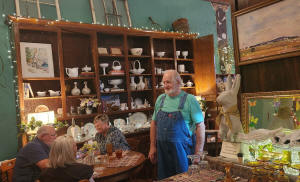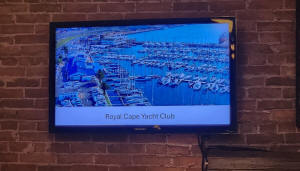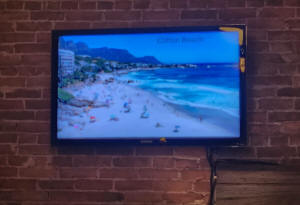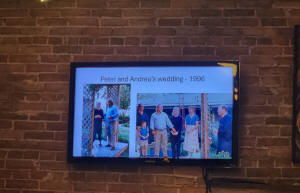|
 Before
speaking, everyone enjoyed a dinner of beef or chicken curry with
sides of chutney, tomato and onion and cucumber with yogurt followed
by dessert. Niehaus went around to each table and described the
dishes he and his wife Andrea had prepared. He said the curry used
in South Africa is less spicy than what we use in America. Before
speaking, everyone enjoyed a dinner of beef or chicken curry with
sides of chutney, tomato and onion and cucumber with yogurt followed
by dessert. Niehaus went around to each table and described the
dishes he and his wife Andrea had prepared. He said the curry used
in South Africa is less spicy than what we use in America.
Elkhart Historical Society’s Gillette Ransom introduced Niehaus by
saying “return with us now to those thrilling days of yesteryear to
what promises to be a wonderful journey that follow’s the highlights
of Peter’s life.” Ransom said those have known Niehaus for a while
have likely heard a few of his more exciting tales.

Over the course of his 80 years, Niehaus has lived in
Holland, South Africa, France and South America. One set of travels
took Niehaus from Panama to Alaska to Cape Horn then back to South
Africa.
Of all the places Niehaus has lived, he said South Africa was his
favorite. His three years as a Navy Engineer building submarines
South of France is a close second.
Because Niehaus has lived so many places, he has American, Dutch and
South African Citizenship and can choose where he wants to go.
Niehaus also speaks nine languages.
Niehaus shared many memories of his youth and said he has many good
memories. He was born in Holland during the last year of World War
II. As Niehaus’ mother would carry him, she could hear bombs nearby.
One bomb fell outside their front door, but Niehaus said it did not
go off. The next day the Germans came. Niehaus said the south of
Holland was under German occupation.

The Germans put the bomb on the back of a truck. At
the turn-off to the highway, the bomb went off. In that situation,
Niehaus felt the saying, “here but for the grace of God go I” was
fitting.
Growing up on a farm in the South of Holland, Neihaus said they had
200 head of dairy cattle. What we call Holstein cows in American are
Friesian cows in Holland. At the young age of eight, Niehaus had to
milk five cows by hand before he went to school each morning. They
plowed with horses. The house the family lived in was 1600 years
old.

There were eight children in Niehaus’ family. His
grandfather lived to the age of 115 and his grandmother lived to the
age of 109.
On his father's side, Niehaus can trace his lineage back nearly
2,000 years. Niehaus said for seven generations of his family, the
eldest son was called Pierre. Though Niehaus’ given name was Pierre,
he said his mother started calling him Peter to make it less
confusing when she called out for him and his father.
Niehaus’ father was an engineer working on the coal mine during the
German occupation. During that time, Niehaus’ father was also a
leader of the resistance in the South of Holland and got caught by
the Germans a couple times, though he escaped and went back home
each time.
A few years after the war, Niehaus’ father got a job as an engineer
in South Africa and went over there by himself initially. The family
had lost some of their land by then and it had been turned into a
commercial airport that is still there today. His father sold the
rest of the land to his brother-in-law, who continued farming it.
A year after his father went to South Africa, Niehaus’ mother and
the eight kids went over there by ship. The trip took about three or
four weeks.
As a child living near the coast in South Africa, Niehaus said he
would dive for lobsters to earn pocket money.
In 1970, Niehaus married his first wife in Cape Town, South Africa.

For three years in the early 70s, Niehaus and his
wife lived in France, where he was an engineer in the Navy. Their
youngest son was born in France.
During those years, he served on the Emily Hobhouse submarine, which
was very efficient and quiet. The submarine went 3,000 meters below
the surface of the ocean. Niehaus said they crossed the equator in
it.
If a ship was coming, Niehaus said Dutch commandants would fire a
signal to let people know the ship was approaching the harbor. That
way, people could get ready in case there was an attack.
After being in France for three years, Niehaus and his family lived
in the married quarters on a Naval base in South Africa. Niehaus
remembers doing lots of camping, caravanning and going to see other
parts of Africa with his wife and kids.
The house the family later lived in was brick and mortar because
Niehaus said wood was not readily available. The roof was tile. He
said they added on to the house.

Once Niehaus was out of the Navy, he became Marine
Superintendent at the Royal Cape Yacht Club. Many boats are moored
in the main harbor by floating moorings. When people would go to the
end of the mooring, they could walk on their boats.
Niehaus owned various boats over the years and did lots of sailing.
His biggest sailboat was a 55-footer with accommodation for ten
people.
At the sea approach to Cape Town from the North, Niehaus said two
mountains that are nearly 200 miles away are visible. The 3,600-foot
mountain Devil’s Peak is to the left of Cape Town. The mountain to
the right of Cape Town is Lion’s Head.
In the harbor near Cape Town, Niehaus said many cargo ships come in
from Cape Point. The biggest cargo ships weigh 750,000 tons. Niehaus
said these ships look like flats when they float past.

Clifton Beach is very beautiful. Niehaus said the sky
there is so blue, when an American Company commissioned his friend
to paint pictures of the surrounding area, the company sent all the
pictures back. The company told his friend the sky could not be that
color.

Cape Town does not have industrial areas, so Niehaus
said there is little air pollution and industrial waste. It does
have quite a bit of culture with opera houses and museums.
Something else Cape Town has is a five-point castle, which is five
miles inland. Niehaus said each point can protect the other points
of the castle.
In South Africa, there were seven stores called Martha’s Vinyard.
Niehaus said years ago, South Africans were very interested in
American crafts, so he made a lot of the craft they sold there.

Later, Neihaus married his current wife Andrea in
Lincoln in 1996 with Judge Coogan presiding.
[to top of second column]
 |

In this area, Neihaus has done quite a bit of
construction. Niehaus helped restore the house Paul Beaver grew up
in along with many other places in Elkhart and Lincoln. There are a
couple of houses on Elkhart Hill Niehaus restored.

When Niehaus and his wife bought the old general
merchant’s store in Elkhart, he said it needed quite a bit of work.
For example, when Niehaus pulled up the old plush carpet in the
building, the whole floor fell into the basement.
After extensive renovation, it now houses two storefronts called
Horsefeathers and the Little Foxes. In the back of these stores is
the Wild Hare Café.

As Niehaus finished sharing his stories, he said he
does not regret much of his life. He did a lot of things when he was
young and thinks it is now time to retire.
Several people then had questions for Niehaus.
One person asked Niehaus how he ended up in this area.
Niehaus’ wife Andrea was once married to a South African man. Over
the years, Niehaus and his wife attended many of the same functions
and they became acquainted.
Andrea Niehaus grew up in Michigan and her sister taught art in
Lincoln. When Andrea wanted to come back home, Niehaus said they
ended up finding a home in Elkhart.
Twenty-one years ago, Niehaus flew five 30-pound cats to America,
paying $5,000 to fly them. The crates had been labelled with the
words big cats, so some thought there were wild cats in them. At
O’Hare Airport, Niehaus said it took a while to round up all the
crates the cats were in.
Someone asked if any of Niehaus’ siblings are still alive.
Of Niehaus’s four sisters and three brothers, he said two sisters
and two brothers are still alive. Three of his siblings live in
South Africa. His oldest sister lives in Sydney, Australia.
Niehaus’ three sons are all married and living in Cape Town. His
oldest son is an engineer who works on oil rigs all over the world.
His middle son works in a body shop fixing cars like Mercedes, BMW
and Volvos. His youngest son owns a division of Volvo. All have done
well for themselves.
Another person asked Niehaus if he wore an oxygen tank to go lobster
diving.

Neihaus said he didn’t wear an oxygen tank. He would
deep dive sixty feet with a weight belt and could hold his breath
for five or six minutes. Beside lobsters, Niehaus said he could grab
abalone, which are marine nails, right off rocks.
There was a question about the submarine Niehaus was on and whether
3,000 feet was a deep depth then.
Niehaus said 3,000 feet was very deep. He said they did a lot of
recording for Americans and took a lot of good pictures from the
submarine.
When asked about the music in Cape Town, Niehaus said the area is
very cosmopolitan. It is culturally well defined in the arts, music,
operas and theaters. He said Cape Town is full of beautiful
theaters. Cape Town has a rich heritage with many Dutch people who
had come from Holland in the 1800s.
There is a little chapel right off Fifth Street in Lincoln that
Niehaus helped build. As Niehaus helped build the chapel, someone
asked what a Dutchman would know about building cabins. Niehaus said
the Dutch were building cabins 1,000 years before America was
discovered.
The next question was whether Niehaus lived in an old or new house
when they lived in Lincoln.
The house in Lincoln was not very old. Now, they live in an old
farmhouse. It was in a pretty bad state when they bought it, but
Niehaus restored it. They used to own a house in Sunset Lake but
sold it when they bought the farmhouse.
A final question was about political changes in South Africa when
Niehaus lived there and how they affected him.
Farmers Niehaus knew built houses for their laborers on the farms.
These farmers raised cattle and often gave the workers a head of
cattle. The workers were buried in the farm cemeteries.
Though many have heard bad things about Apartheid, Niehaus said
there were some good things about it too.
To Niehaus, one good thing was his children going to school with
children of various ethnic backgrounds. He and his children had many
black friends in South Africa.
Apartheid had nothing to do with political situations in Niehaus’
experience.

The embargoes were about gold, diamonds and precious
metals the rest of the world wanted for nothing. Niehaus said South
Africa held these metals for ransom because it is all they had.
Niehaus felt the embargo was all about money. When the embargo was
put on South Africa, the workers suffered the most. In large
companies, Niehaus said the presidents and vice-presidents got big
handouts and the people working for these companies were just put
out on the street.
The problems were more about money than anything else. Niehaus said
the conflicts affected everyone and many people left South Africa.
Some of these families had been there for generations.
When Niehaus left South Africa, he could only take $30,000.
There were a lot of problems, but Niehaus said it was not that easy
to resolve those problems. In America, there are problems, too and
Niehaus said no one seems to be able to resolve some of them.
Some of the positive memories Niehaus has of South Africa are the
birds and the flowers. He said the West Coast of South Africa is
semi-desert, but within two weeks of the rains, it turns into the
most glorious paradise of flowers one has ever seen.
With the many birds in South Africa, Niehaus said there is a riot of
colors for hundreds of square miles. The combination of colors is
something Niehaus has not seen anywhere else.
Diamonds can be found on the West Coast of South Africa, but Niehaus
said it is illegal to have an uncut diamond in your possession in
South Africa. Debeers controls the diamond industry there.
There are rooms filled to the ceiling with diamonds. Niehaus said
after low tide, workers go in with bulldozers. The bulldozers lift
the sand off from the seashore as far as they can reach before the
tide changes. Next, Niehaus said they send around 200 or 300 guys
with dust masks and brooms to sweep the diamonds out of the
crevices. The diamonds are then put in forty-gallon tubs.
Once Niehaus had finished answering the questions, he said “that’s
enough.” He had provided insights into a world those at the lecture
did not know about before. Niehaus has enough stories, he said he
could have gone on for hours, but decided to stop after sharing many
of the highlights from his life.
Friday, September 20 will be the next Elkhart Historical Society
dinner lecture at the Wild Hare Café with Bill Walter speaking about
the restoration of the Logan County Courthouse. Walter is the
project manager of the courthouse restoration. His other projects
have included working on the White House in Washington, D.C., the
Kentucky State Capitol building, the Michigan State Capitol
building, the Texas Governor’s Mansion and many others. Reservations
can be made in the next few weeks by calling 217-947-2238.
[Angela Reiners]
|